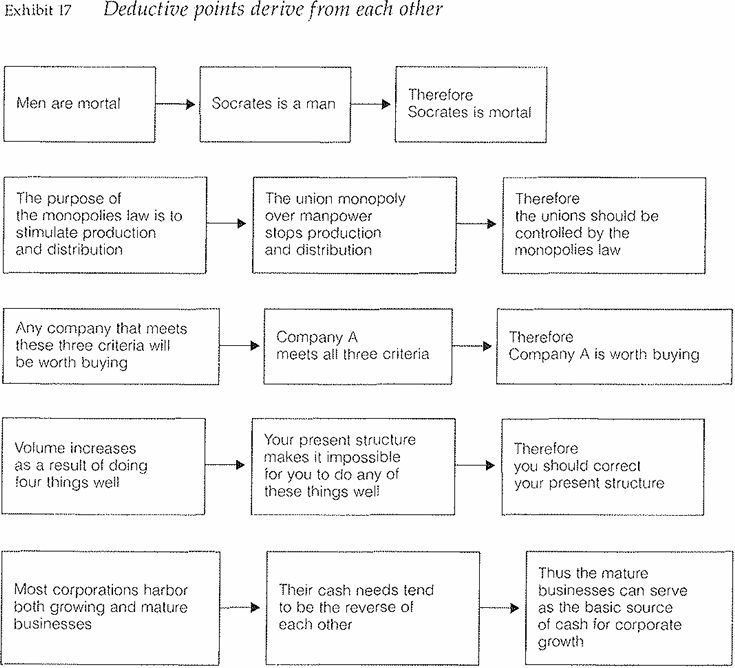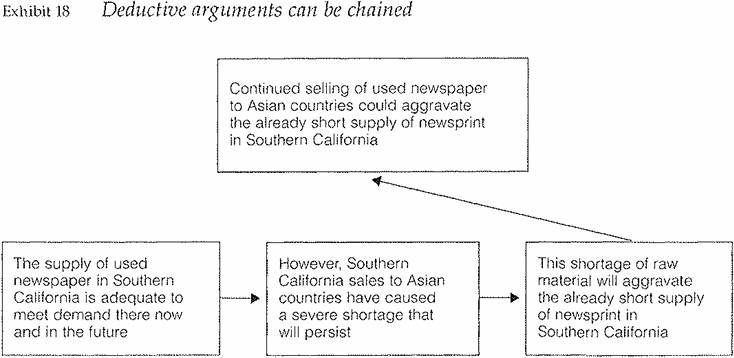
DEDUCTIVE REASONING
 المؤلف:
BARBARA MINTO
المؤلف:
BARBARA MINTO
 المصدر:
THE MINTO PYRAMID PRINCIPLE
المصدر:
THE MINTO PYRAMID PRINCIPLE
 الجزء والصفحة:
61-5
الجزء والصفحة:
61-5
 2024-09-12
2024-09-12
 1595
1595
DEDUCTIVE REASONING
Deductive reasoning appears to be the pattern the mind generally prefers to use in most of its thinking, possibly because it is easier to construct than inductive reasoning. In any case, it is usually the pattern one follows in problem solving, and therefore the one people attempt to follow in communicating their thinking. But while it is a useful way to think, it is a ponderous way to write, as I shall hope to show.
How It Works
First, let's understand what deductive reasoning is. It is usually described as taking the form of a syllogism-an argument in which a conclusion is inferred from two premises, one major and one minor. I find these terms confusing in explaining how deductive reasoning works in writing, and so I will not use them again.
Instead, think of a deductive argument as needing to do three things:
- Make a statement about a situation that exists in the world.
- Make another statement about a related situation that exists in the world at the same time. The second statement relates to the first if it comments on either its subject or its predicate.
- State the implication of these two situations existing in the world at the same time.

Exhibit 17 shows several deductive arguments, each of which can be seen to do precisely these three things. And in each case the point at the top should roughly summarize the ideas grouped below, resting heavily on the final point. Thus, "Because Socrates is a man he is mortal," or "Since the unions behave as a monopoly, they should be controlled by the monopolies law," or "If you want to increase your volume, you must change your present structure," and so forth.
These are examples of deductive arguments in which each step of the reasoning has been included. But sometimes you will find yourself wanting to skip a step and chain two or more deductive arguments together, since to put in every step would take too long and sound pedantic. This chaining of arguments is perfectly permissible, provided that your reader is likely to grasp and agree with the missing steps.

Exhibit 18 gives an example of a chained deductive argument that should probably go something like this:
-We produce enough used newspaper to meet our own demand.
- But we have sold the product to other countries.
- Therefore we have a shortage.
- A shortage of used newspaper causes a shortage of newsprint.
- We have a shortage of used newspaper.
- Therefore we have a shortage of newsprint.
You can see how tedious this argument would be to read if you put in every step, and in general that is my major complaint about the use of deductive arguments in writing. They are tedious, primarily because they make a mystery story out of what should be a straightforward point.
 الاكثر قراءة في Writing
الاكثر قراءة في Writing
 اخر الاخبار
اخر الاخبار
اخبار العتبة العباسية المقدسة


